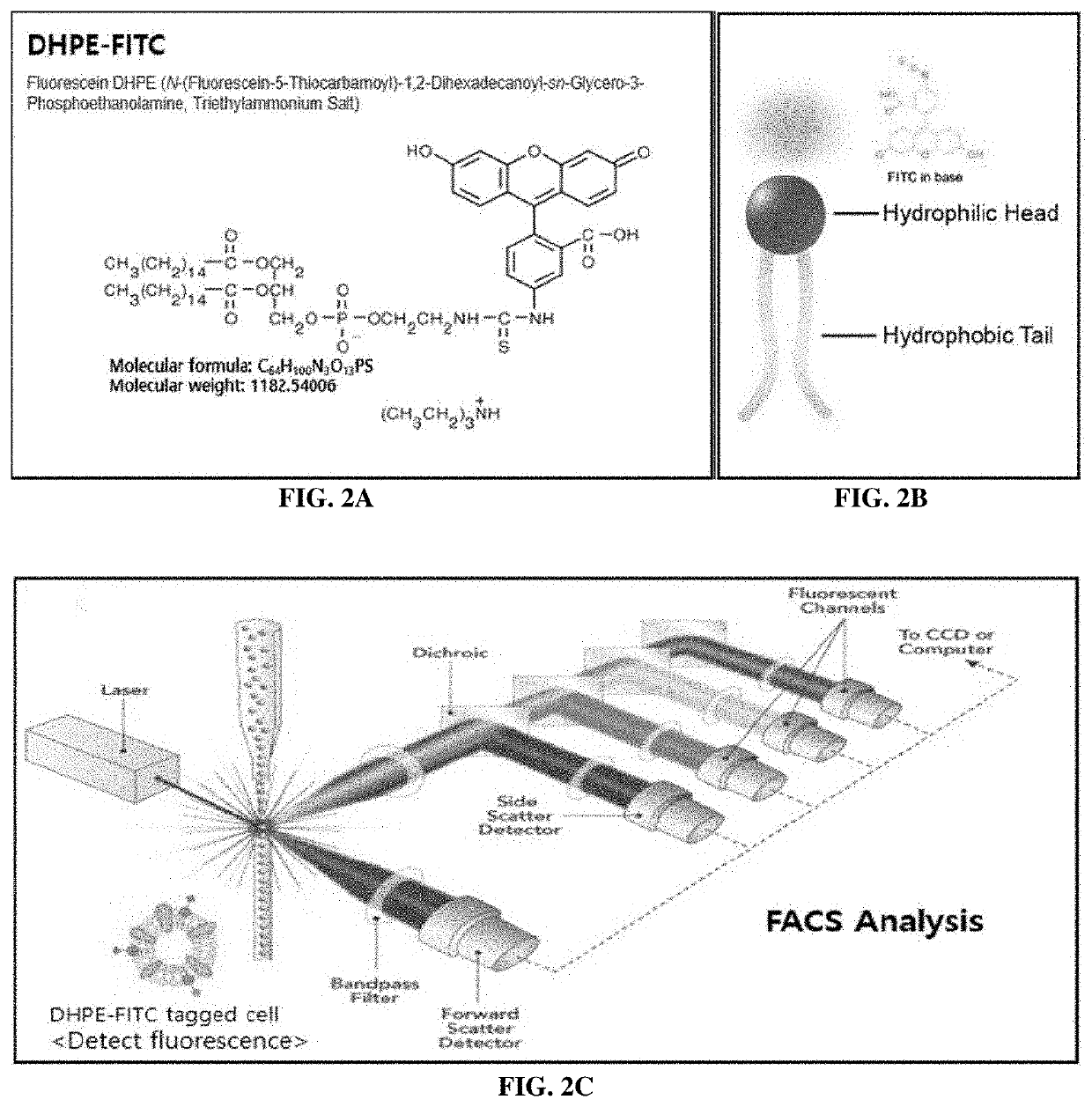Magnetic-based biopanning method through attachment of magnetic bead to cell
a magnetic bead and biopanning technology, applied in the field of magnetic bead attachment to cells, can solve the problems of immunoreactivity, long development time, and increased risk of infection
- Summary
- Abstract
- Description
- Claims
- Application Information
AI Technical Summary
Benefits of technology
Problems solved by technology
Method used
Image
Examples
example 2
ion and Optimization of Fusion of Biotin-Bound Cell-Membrane-Like Substances to Cell
[0091]The test was conducted using the substance actually attached to the magnetic beads, namely, BX DHPE (N-((6-(biotinoyl)amino)hexanoyl)-1,2-dihexadecanoyl-sn-glycero-3-phosphoethanolamine, triethylammonium salt, produced by Invitrogen Corporation), under various concentration conditions (0.5 mg / ml, 0.25 mg / ml, 0.125 mg / ml and 0.0625 mg / ml) (FIG. 4).
[0092]First, HCC.95, a cancer cell line, was dispensed into 500,000 cells under each condition, and the reaction volume was 300 μl. The cultured sample was centrifuged at 1,500 rpm for 3 minutes with 1% FBS solution and was then washed to remove the supernatant. This was repeated twice. Then, streptavidin-FITC (fluorescent material) having binding capacity specific to biotin was reacted at 4° C. for 1 hour. The cultured sample was centrifuged at 1,500 rpm for 3 minutes with a 1% FBS solution and was then washed to remove the supernatant. This was repea...
example 3
ion of Surface Protein Expression in Cells Fused with Cell-Membrane-Like Substance
[0096]Although a cell-membrane-like substance is fused to a cell, it is not suitable for use in phage-display-based cell panning when there is a change in surface protein expression. Therefore, it was confirmed that the optimized conditions of B-X DHPE did not affect the cell surface protein, and the amount of B-X DHPE that fused to the cell surface was also confirmed.
[0097]GBM15-682T, a patient-derived cell, was used. This cell overexpresses the FGFR3 cell surface protein and thus is suitable for comparison of expression level. The expression level of the FGFR3 cell surface protein was measured through a flow cytometer under the condition in which the cell-membrane-like substance (B-X DHPE) was fused and under the condition in which the cell-membrane-like substance was not fused. GBM15-682T was dispensed into 500,000 cells under each condition, was used in a reaction volume of 300 μl, and reacted with...
example 4
of Magnetization Through Attachment of Magnetic Beads to Cells Fused with Cell-Membrane-Like Substances and Optimization of Conditions
[0100]4-1: Confirmation of Effect of Complex-Binding Method
[0101]B-X DHPE fused to cells contains a biotin component and thus has binding capacity specific to streptavidin. Therefore, it is possible to induce magnetism in cells using streptavidin-attached magnetic beads (Streptavidin Dynabeads: Dynabeads M-280 streptavidin; Invitrogen Corporation). As a method of inducing magnetization by attaching magnetic beads to cells, a direct method and an indirect method were compared. The direct method refers to a method of first reacting B-X DHPE with streptavidin Dynabeads and then fusing the result to cells, and the indirect method refers to a method of fusing B-X DHPE to the cells and then reacting the result with streptavidin Dynabeads.
[0102]The direct method was carried out as follows. 3.0 μg of B-X DHPE was reacted with 500 μg of streptavidin Dynabeads ...
PUM
| Property | Measurement | Unit |
|---|---|---|
| Magnetism | aaaaa | aaaaa |
Abstract
Description
Claims
Application Information
 Login to View More
Login to View More - R&D
- Intellectual Property
- Life Sciences
- Materials
- Tech Scout
- Unparalleled Data Quality
- Higher Quality Content
- 60% Fewer Hallucinations
Browse by: Latest US Patents, China's latest patents, Technical Efficacy Thesaurus, Application Domain, Technology Topic, Popular Technical Reports.
© 2025 PatSnap. All rights reserved.Legal|Privacy policy|Modern Slavery Act Transparency Statement|Sitemap|About US| Contact US: help@patsnap.com



